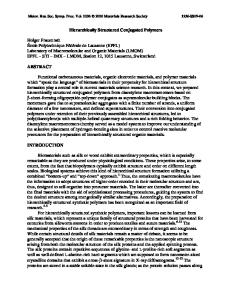Physics of Conductive Conjugated Polymers
- PDF / 413,231 Bytes
- 15 Pages / 595 x 842 pts (A4) Page_size
- 18 Downloads / 443 Views
Physics of Conductive Conjugated Polymers∗ A Primer Hemanth K Bilihalli
In this expository article, the importance of electron-phonon coupling to charge transport in conductive polymers—as a result of a vanishing dynamic bandgap—is outlined. The author’s interpretation of physical models for this process: models are presented for predicting the conduction modes activated during charge transport.
1. Foreword The well-known H¨uckel rule of physical chemistry states that organic rings with (4n + 2) electrons in Π-bonded orbitals exhibit ‘resonance’ or ‘delocalization’ of electrons. A similar condition holds in linear conjugated oligomers with half this number of Π-bonded electrons, with facility for charge transport, in the presence of ‘dopant’. Thus, it came as a surprise in 1977 that long conjugated organic polymers were found to conduct electricity when polyacetylene was prepared by accidental addition of ≈1000 times the required amount of the polymerization catalyst (acting as a dopant). The practical applications of conductive polymers are—to quote the public announcement of the 2000 Chemistry Nobel Prize [1], “...in low-cost manufacturing using solution-processing of film-forming polymers. Light displays and integrated circuits, for example, could theoretically be manufactured using simple inkjet printer techniques.”
Hemanth K Bilihalli obtained his PhD in Chemical Engineering from Indian Institute of Technology Madras in 2013. The PhD work at IIT Madras exposed the author to simple ab initio ‘jellium’ and ‘pseudopotential’ models of metals. The present work was completed during a tenure of Assistant Professorship at R.V College of Engineering, Bengaluru.
Keywords Phonon-electron interactions, lo-
Some examples of commercially employed conductive polymers ∗
calization effects, hopping transport, Le polymers.
Vol.25, No.7, DOI: https://doi.org/10.1007/s12045-020-1011-1
RESONANCE | July 2020
947
GENERAL ARTICLE
are: polyaniline, poly(ethylenedioxythiophene), poly(phenylene vinylidene), poly(dialkylfluorene), poly(thiophene), poly(pyrrole), etc. These are primarily employed in anti-static coatings for electronic circuits, and sometimes in transistors and capacitors. More recently, electroluminescent polymers have been discovered [poly(pphenylene vinylene) in 1990] that can form the active layers in light emitting diodes (LEDs). Apart from their technological impact, research on these materials has proven to be fertile ground for testing novel theories on conduction-insulation transition. A cursory overview of conducting polymer structure via Raman spectrum analysis reveals a small (but electrically significant) alternation in bond length along the polymer chain (≈0.08Å in the case of polyacetylene) [2], contrary to the “resonance school of thought” about such conjugated systems. One of the themes of this article, is the physics of coupling between the electron and the crystal lattice, in addition to the pedagogical aim of explaining charge conduction in terms of ‘a bandgap eliminating midgap state’. Thi
Data Loading...











